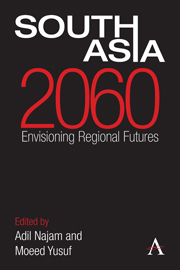Book contents
- Frontmatter
- Contents
- Acknowledgments
- List of Abbreviations
- Introduction: Imagining South Asian Futures
- Section I South Asia as a Region
- Section II State Relations
- Section III Development
- Section IV Human Well-Being
- Chapter 27 Population Dynamics, Economic Prospects and Regional Coherence
- Chapter 28 Towards Cooperation for Poverty Reduction?
- Chapter 29 Health Challenges
- Chapter 30 Regional Disease Dynamics
- Chapter 31 Education: Time Bomb or Silver Bullet?
- Chapter 32 Scholarship in and on South Asia
- Chapter 33 Rights and Justice: A Prospective View
- Chapter 34 Patriarchy, Power and Paradox: Dreaming Gender Equality and Development
- Chapter 35 Women in South Asia
- Chapter 36 Media: New Trends, Old Problems
- Chapter 37 Sports: Passion and Industry
- About the Authors
- Bibliography
- Index
Chapter 27 - Population Dynamics, Economic Prospects and Regional Coherence
from Section IV - Human Well-Being
Published online by Cambridge University Press: 05 September 2013
- Frontmatter
- Contents
- Acknowledgments
- List of Abbreviations
- Introduction: Imagining South Asian Futures
- Section I South Asia as a Region
- Section II State Relations
- Section III Development
- Section IV Human Well-Being
- Chapter 27 Population Dynamics, Economic Prospects and Regional Coherence
- Chapter 28 Towards Cooperation for Poverty Reduction?
- Chapter 29 Health Challenges
- Chapter 30 Regional Disease Dynamics
- Chapter 31 Education: Time Bomb or Silver Bullet?
- Chapter 32 Scholarship in and on South Asia
- Chapter 33 Rights and Justice: A Prospective View
- Chapter 34 Patriarchy, Power and Paradox: Dreaming Gender Equality and Development
- Chapter 35 Women in South Asia
- Chapter 36 Media: New Trends, Old Problems
- Chapter 37 Sports: Passion and Industry
- About the Authors
- Bibliography
- Index
Summary
What do we foresee for South Asia in 2060, in light of the significant changes it has undergone in the past few decades? India has experienced rapid economic growth, but continues to suffer widespread, extreme poverty as well. Afghanistan, Nepal and Sri Lanka have seen major conflicts, with Pakistan always seeming on the verge of a major eruption. Nepal and Sri Lanka finally seem to have moved toward peace. As elsewhere, the region's many developments and crosscurrents make reliable predictions difficult, but one relatively neglected set of factors – demographic change – may shed some light on the region's future. Throughout the world, falling mortality rates and declining birth rates have been predictive of growing per capita incomes, and theoretical reasoning and related evidence are sufficiently compelling to think that the links may indeed be causal. In this vein, this essay explores South Asia's economic prospects through a demographic lens.
In addition, as we will see, there are some similar demographic trends across the countries of South Asia, but there are also a number of extreme differences. Regional heterogeneity bears on the question: “To what extent is South Asia a coherent region?”
- Type
- Chapter
- Information
- South Asia 2060Envisioning Regional Futures, pp. 211 - 220Publisher: Anthem PressPrint publication year: 2013



